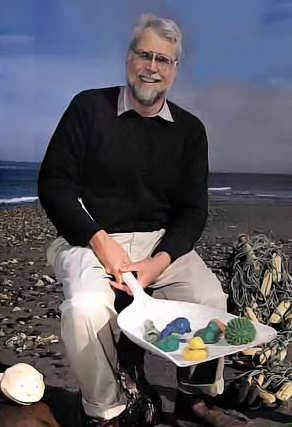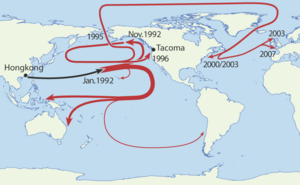Friendly Floatees spill facts for kids

Friendly Floatees are plastic bath toys like rubber ducks. They became famous because of a scientist named Curtis Ebbesmeyer. He studies ocean currents by watching how floating objects move.
In 1992, 28,800 Friendly Floatees were lost at sea. These toys included yellow ducks, red beavers, blue turtles, and green frogs. Some toys washed up on Pacific Ocean beaches, like in Hawaii. Others traveled over 27,000 kilometers (17,000 miles). They even floated over where the Titanic sank. Some spent years frozen in Arctic ice. Fifteen years later, in 2007, they reached the U.S. East Coast, and even British and Irish shores.
Contents
The Amazing Journey of Friendly Floatees
The Friendly Floatee toys were made in China. They were being shipped from Hong Kong to Tacoma, Washington. On January 10, 1992, a big storm hit the ship. This happened in the North Pacific Ocean, near the International Date Line. Twelve large shipping containers fell into the ocean.
One of these containers held all 28,800 Floatees. The container opened, perhaps by hitting other containers or the ship. This let the toys escape into the sea. Even though the toys were in cardboard, the cardboard quickly fell apart in the saltwater. Unlike many bath toys, Friendly Floatees have no holes. This means they do not fill with water and sink.
How Scientists Tracked Them
Two scientists, Curtis Ebbesmeyer and James Ingraham, started tracking the toys. They were already studying ocean currents. Releasing 28,800 objects at once was very helpful. Usually, scientists release only 500 to 1,000 drift bottles. With so many Floatees, they expected to find many more. They had also tracked other lost items, like 61,000 Nike running shoes in 1990.
Ten months after the toys were lost, the first ones appeared. A person found ten toys near Sitka, Alaska, on November 16, 1992. This was about 3,200 kilometers (2,000 miles) from where they started. The scientists asked people along the coast to help find the toys. By August 1993, about 400 toys were found along the eastern coast of the Gulf of Alaska.
The scientists used a computer model called OSCUR. This model uses air pressure data to figure out wind direction and speed. It also calculates ocean surface currents. This model helps predict where floating objects will go. It can also help find people lost at sea.
What Happened Next?
Using their models, the scientists correctly guessed where more toys would land. They predicted toys would reach Washington state in 1996. They also thought many toys would travel to Alaska, then to Japan, and back to Alaska. After that, they would drift north through the Bering Strait. The scientists believed the toys would get stuck in the Arctic ice.
They predicted it would take five or six years for the toys to cross the North Pole with the ice. Then, the ice would melt in the North Atlantic, releasing the toys. From July to December 2003, the toy company offered a $100 US savings bond reward. This was for anyone who found a Floatee in New England, Canada, or Iceland.
More toys were found in 2004 than in the three years before. Scientists predicted even more would head past Greenland. They thought these toys would land on the southwestern shores of the United Kingdom in 2007. In July 2007, a retired teacher found a plastic duck in Devon, UK. Newspapers thought the Floatees had arrived. But later, a scientist checked the toy. He said it was not one of the original Friendly Floatees.
Over time, the sun and seawater changed the toys. The yellow ducks and red beavers faded to white. But the blue turtles and green frogs kept their original colors.
Floatees' Lasting Impact
The story of the Friendly Floatees has inspired many things. At least two children's books have been written about them.
- In 1997, Clarion Books published Ducky. It was written by Eve Bunting and illustrated by David Wisniewski.
- Hans Christian Andersen Award winner Eric Carle wrote 10 Little Rubber Ducks in 2005.
In 2003, Rich Eilbert wrote a song called "Yellow Rubber Ducks." He later made it into a YouTube video in 2011.
In 2011, Donovan Hohn published a book called Moby-Duck: The True Story of 28,800 Bath Toys Lost at Sea and of the Beachcombers, Oceanographers, Environmentalists, and Fools, Including the Author, Who Went in Search of Them.
On June 20, 2014, The Disney Channel aired Lucky Duck. This animated TV movie was loosely based on the Friendly Floatees.
Poet Kei Miller wrote a poem about the Floatees in 2014. It is called "When Considering the Long, Long Journey of 28,000 Rubber Ducks."
The toys were also mentioned in a 2022 game called "Placid Plastic Duck Simulator." It was called an "accidental duck experiment" on the radio.
Today, the original Friendly Floatees have become collector's items. Some have sold for as much as $1,000!
See also
- Drifter (floating device)
- Great Pacific garbage patch
- Hansa Carrier
- Marine debris
- Message in a bottle
- Rye Riptides
 In Spanish: Friendly Floatees para niños
In Spanish: Friendly Floatees para niños


